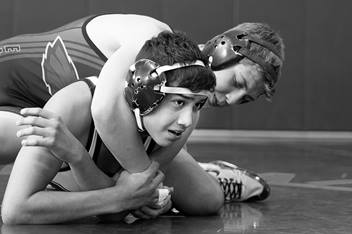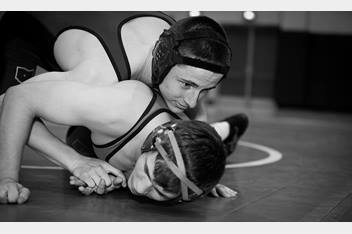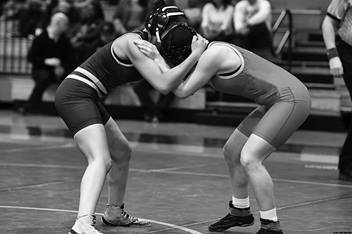Wrestling and Skin Conditions - What Is THAT?
All of these skin diseases MAY NOT BE COVERED FOR COMPETITION!
Report anything suspicious to your athletic trainer or physician ASAP so you can stay competitive!
The sport of wrestling requires close skin-to-skin contact amongst opponents. This close contact means there is a high possibility of catching or spreading a variety of skin conditions amongst competitors. Various different common skin conditions are outlined below, so that you can be aware, identify and get treatment for as soon as possible, so that you can stay on the mat and not on the sidelines.
Herpetic Lesions
Herpetic Lesions (aka herpes simplex, herpes zoster, herpes gladiatorium, cold sore/fever blister) are a viral infection transmitted by direct contact and may appear ANYWHERE ON THE BODY.
Signs and Symptoms:
- Lesion: Numerous clustered vesicles (blisters) filled with clear fluid on a reddened background. The vesicles continue to develop for 7-10 days and eventually become dry, crusted lesions. Recurrent outbreaks are sometimes preceded by irritability, headache, and tingling, burning and/or itching of the skin at the site of recurrence
- Other symptoms may mimic a mild viral illness with fever, joint aches and pains, sore throat, swollen lymph nodes near the affected area and inflammation of the eyes
Return to Play Guidelines:
- Initial outbreaks require minimum of 10-14 days of treatment with oral antiviral medication as prescribed by a physician
- Recurrent outbreaks must complete a minimum 120 hours (5 days) oral antiviral medication
- Must be free of fever, swollen lymph nodes, malaise (feeling ill), etc.
- Existing lesions must be covered in a dry crust (scab), with no oozing or discharge and no new blisters developed in past 72 hours (3 days)
- NOTE: Active, wet lesions cannot be covered to allow participation
Tinea aka Ringworm
Ringwormis a fungal infection that can be seen anywhere but most commonly affects the skin on the body (tinea corporis), the scalp (tinea capitis), the feet (tinea pedis, or ‘athlete's foot’), or the groin (tinea cruris, or ‘jock itch’).
Signs and Symptoms:
- Tinea corporis lesion: Round, reddened, scaly plaque with raised borders
- Tinea capitis lesion: Round, gray scaly patches accompanied by mild hair loss
- Tinea pedis lesion: Common in the toe webs, skin is usually complemented by thick scaling
- Though normally circular in shape, the lesion may present with a more irregularly shaped border in athletes
Return to Play Guidelines:
- Oral or topical fungicide medicine as prescribed by physician for at least 72 hours (3 days) for tinea corporis or 14 days for tinea capitis (on the scalp).
- Once lesion is considered to no longer be contagious, it must be adequately covered (occlusive dressing) when the athlete is cleared to return to activity
Molluscum Contagiosum
Molluscum Contagiosum is a viral infection transmitted by skin-to-skin contact.

Signs and Symptoms:
- Lesion: fleshed-colored to light-pink pearly papules with a dent or depression in the middle. Often, a small predominantly itchy patch of eczema can develop around the lesions a month or more after development
Return to Play Guidelines:
Lesions must be curetted (scraped out) by a physician and subsequently covered for competition.
Impetigo
Impetigo is a superficial bacterial infection most commonly found on the face, neck, and upper extremities. It is highly contagious and MAY NOT be covered for competition without treatment.
Signs and Symptoms:
- Lesions: begins as a thin-walled vesicle that ruptures to expose a raw surface covered in a yellowish-brown or honey-colored crust. In the early stages it may also present as a superficial blister that ruptures easily
Return to Play Guidelines:
- No new skin lesions for at least 48 hours (2 days)
- Completion of a 72 hour (3 day) course of directed antibiotic therapy
- No further drainage from the wound
- Active lesions MAY NOT be covered for competition
Folliculitis, Furuncles, Carbuncles
Folliculitis is an infection of the hair follicles that appears in areas of high friction and perspiration and is caused by a bacteria (most commonly Staphylococcus aureus). Furuncles (boils) and carbuncles (larger boils) are complications of this infection. Active infections MAY NOT be covered for competition.
Signs and Symptoms:
- Folliculitis lesion: red or white bumps at the base of the hair follicles, especially in areas that have been shaved, taped, or abraded
- Furuncle lesion: tender, red, nodular swelling
- Carbuncle lesion: when multiple furuncles join, a mass of pus filled tissue develops with localized redness and swelling. A fever also may be preset.
Return to Play Guidelines:
- Completion of 72 hour (3 day) course of antibiotic therapy
- No further drainage from the wound
- No new skin lesions for at least 48 hours (2 days). Any remaining dry, scabbed lesions should be covered during competition
MRSA aka Methicillin-Resistant Staphylococcus Aureus
MRSA aka Methicillin-Resistant Staphylococcus Aureus is a severe bacterial infection that common antibiotics cannot treat. MRSA lesions often can confused as spider bites. It is a highly contagious and potentially dangerous infection. Active lesions MAY NOT be covered for competition
Signs and Symptoms:
- Lesion: Initially, lesions can look very similar to folliculitis/furuncle/carbuncle infections. Develops quickly from small pustules into larger pustules or abscesses with swelling, redness, and possibly black markings
- Other symptoms may include systemic infections symptoms such as fever, fatigue, etc.
Return to Play Guidelines:
- Completion of 72-hour (3 day) course of directed antibiotic therapy.
- No further drainage from the wound
- No new skin lesions for at least 48 hours (2 days)
- Inactive, dry, healing lesions need to be covered for competition
Prevention:

- Perform a daily full-body skin check and report any suspicious lesions to your Athletic Trainer or physician as soon as it appears.
- Have all game and practice gear laundered daily.
- Follow good personal hygiene practices:
- SHOWER with antimicrobial soap immediately after practices and games and wash hands frequently.
- AVOID sharing towels, razors, athletic equipment, water bottles, and hair clippers.
- AVOID body shaving.
- AVOID entering common whirlpools or tubs if skin lesions are present.
REPORT IT!
The sooner you report it, the sooner you get treatment and the sooner you return to play.
These diseases are all highly contagious. Hiding or failing to notice them could have serious consequences, such as…
- The disease may be passed to your teammates and/or opponents.
- If not treated, some of these diseases can lead to potentially dangerous complications –and thus more time out of practice and competition.
MRSA Photo Courtesy of Bruno Coignard, M.D., Jeff Hageman, M.H.S and the CDC
Tinea (Ringworm) and Molluscum Contagiosum Photos Courtesy of Dermatology at Nationwide Children's Hospital
Herpetic Lesions and Impetigo Photos Courtesy of Sports Medicine at Nationwide Children's Hospital
Consult your primary care physician for more serious injuries that do not respond to basic first aid. As an added resource, the staff at Nationwide Children’s Hospital Sports Medicine is available to diagnose and treat sports-related injuries for youth or adolescent athletes. Services are available in multiple locations. To make an appointment, call (614) 355-6000 or schedule an appointment online.




